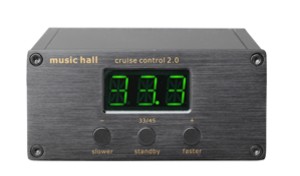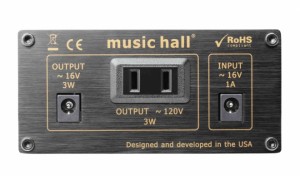TurntablePSU.comReviews and Technical Analysis
Music Hall Cruise Control


Overview
The $299 Music Hall Cruise Control 2.0 is a Variable Frequency Drive (VFD) that uses PWM to generate the sinewave signal. The unit uses an ST-Micro 12C5204AD microprocessor to generate the PWM, control the display and accept commands from the user. The clock source for the microprocessor is a 12MHz crystal oscillator with a frequency stability of .01% (100 PPM). The display uses 3 large LEDs to indicate speed and the front panel has 3 buttons to switch between 33/45 RPM and to control the output frequency for each speed in 0.1 RPM steps.
The case of the Crusie Control is a one piece aluminum extrusion with black anodized finish. The end panels are 0.062" thick aluminum with black anodizing.
The Cruise Control is powered by a 120VAC input, 16VAC 1A output wall wart and the PSU has two outputs: one for 16VAC motors and one for 120VAC motors, both rated at 3W maximum, but not simulatneously. The output voltage is fixed. Unlike most of the other PSUs on the market, the Cruise Control uses 44.444 Hz for 33 RPM and 60 Hz for 45 RPM, so the turntable belt must be installed on the large spindle of the pulley (45 RPM). This was a curious choice as all the motors we tested the PSU with had considerably more vibration at 33 RPM than if we plugged the table directly into the wall. The manual advises the user to start in 33 RPM mode and switch to 45 RPM rather than starting in 45 RPM mode. The Cruise Control does not work with 50Hz motors.
The turntable can be used at 78 RPM if the motor is fitted with the optional pulley. The Cruise Control output is switched to 45 RPM display (60 Hz) and the platter will spin at 78 RPM. 33 RPM is not available in this mode (platter will spin at ~57 RPM) and 45 RPM becomes 78 RPM. The tempo control changes to ~ ±0.175 RPM instead of ±0.1 RPM.
Circuit Description
The PWM signal is output on pin 11 of the microprocessor and low pass filtered by one half of an NE5532 opamp configured as a 2 pole Sallen-Key filter with a cut-off frequency of 185Hz. The other half of the NE5532 drives a complimentary pair of bipolar transistors in push-pull arrangement. The output of the bipolar amp is AC coupled to the low voltage side of a 6VAC-120VAC 6W toroidal transformer with the high voltage windings in series to get to 120VAC at the output. The output of the low pass filter also drives another NE5532 and complimentary bipolar transistor amp configured for a bridge tied load (BTL) output to produce 16VAC from ±21VDC rails.
Measurements
The output frequency at 33.3 RPM measured 44.52 Hz (44.44 Hz expected) and 59.8 Hz at 45 RPM (60.0 Hz expected). Adjustment range of the speed was ±1.0 RPM in 0.1 RPM steps for both 33 and 45 RPM modes. No load voltage at the 16VAC output was 14.5VAC; the output dropped to 13.8VAC at 3W. The no load voltage at the 120VAC output was 113.6VAC; the output dropped to 99VAC at 3W.
Specifications
Nominal Speeds...........................33 and 45 RPM (78 RPM Optional with modified pulley).
Speed Stability.............................0.0001% (possible typo, unit uses an uncompensated 0.01% crystal)
Distortion (Freq Generator).............0.4%
Distortion (16VAC output)..............1.75%
Distortion (115VAC output).............2.4%
Pitch Control................................20 step/0.1 RPM
Output Power...............................3W
Output Impedance........................650 Ohms
Reduced Voltage..........................Not available
Turntable Connection....................16VAC 2.1mm and 120VAC NEMA 1-15
Outboard Supply..........................120VAC input 16VAC 1A output
Dimensions..................................4.2"W x 5.8"L x 2.0"H
Weight.........................................1.43 lbs.
Retail...........................................$299